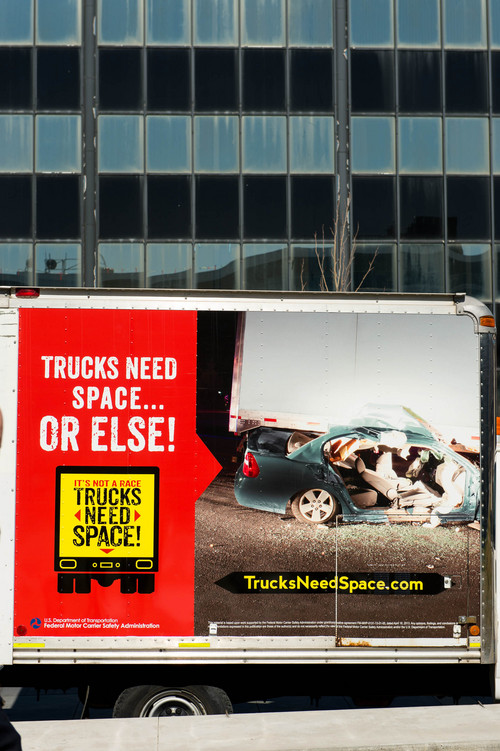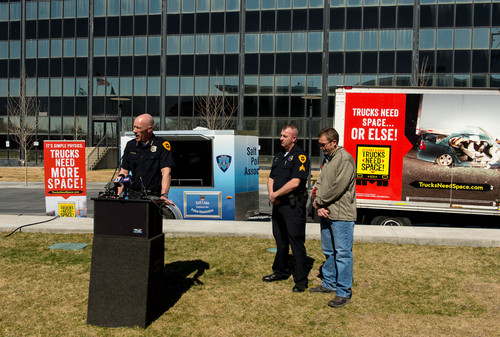This is an archived article that was published on sltrib.com in 2014, and information in the article may be outdated. It is provided only for personal research purposes and may not be reprinted.
It's one of the hardest parts of Sgt. Tom Potter's job: knocking on someone's door at 2 a.m. and telling them their loved one was in a fatal crash.
Potter, who has investigated crashes for Salt Lake City police the past 13 years, knows in detail how much energy and force a commercial truck is carrying even as it tries to brake before it kills someone. He has the physics degree and the bad news to prove it.
"It ruins their whole night; it ruins their whole life," Potter said. So the Salt Lake City Police Department is spending about $669,000 in federal grant money to remind everyone to give trucks more space.
The campaign includes three TV commercials, two radio advertisements, billboards, posters, a website and a city truck with a wrap-around ad displaying destructive crash aftermath. The truck will be parked at events such as Utah Jazz games — it already showed up outside EnergySolutions Arena on Monday night — to get people to be more careful around the massive vehicles.
"Far too often, we have crashes occur that take people's lives," Police Chief Chris Burbank said. His department investigates thousands of truck-involved crashes a year. "It's not a race."
Salt Lake Valley is home to at least 45 trucking companies and Salt Lake City serves as a major thoroughfare for interstate commercial transport, Burbank said.
Christopher Smith has been driving commercial trucks in Salt Lake City for more than 20 years. He's seen the pedestrians, cyclists and fellow drivers who dart across the road or fail to give him the berth he needs.
Smith recalled how one driver directly ahead of him lost control of his vehicle, and Smith was scared that he was going to hit him. His truck would not have had enough time to stop. It takes longer for commercial trucks to stop than it does for cars, not only because of their mass but also because they use an inherently slower air-brake system rather than brake pads.
"We don't stop on a dime just like cars," Smith said.
Fortunately, the driver regained enough control to move out of the way — but not everyone is so lucky.
In 2008, commercial vehicles were involved in 6,616 crashes in Salt Lake City alone, according to the police department. The totals have ebbed and flowed, but generally declined through 2013, when there were 2,659 crashes in the city. So far this year, there have been 342.
While safety around the big-wheeled behemoths seems to have improved over the past six years, there is still room for improvement.
"It is paramount to share the road," Potter said. If a car and truck are traveling at the same speed, a truck will need more than twice the distance to stop than a car.
Smith urged other drivers to always signal their turns; pass trucks quickly and on the left, where the truck driver can best see them; give trucks a lot of room to stop; and avoid hovering in truck's blind spots.
Three federal grants from the Federal Motor Carrier Safety Administration funded research and focus groups to develop the campaign, the production and running of the ads and enforcement and evaluations to try to reduce crashes.
For more information, visit trucksneedspace.com. People who pledge to be safer, through the website, can win Jazz tickets or a $100 gift card.
Twitter: @mikeypanda











